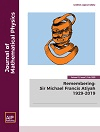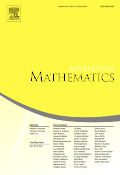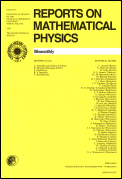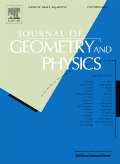
REVIEWS IN MATHEMATICAL PHYSICS
Scope & Guideline
Advancing Knowledge in Mathematical and Statistical Physics
Introduction
Aims and Scopes
- Interdisciplinary Applications:
The journal emphasizes the interplay between mathematics and physics, publishing works that utilize mathematical techniques to solve complex problems in theoretical physics. - Advanced Mathematical Techniques:
Papers often explore sophisticated mathematical frameworks, including but not limited to operator algebras, spectral theory, and gauge theory, providing new insights into physical phenomena. - Quantum Field Theory and Statistical Mechanics:
A significant portion of the journal's content is devoted to quantum field theory (QFT) and statistical mechanics, where mathematical rigor is applied to understand quantum systems and phase transitions. - Topological and Geometric Methods:
The journal encourages research that employs topological and geometric approaches, enhancing the understanding of physical theories through the lens of modern mathematics. - Integration of Classical and Quantum Mechanics:
Focus is given to works that bridge classical and quantum mechanics, exploring their mathematical foundations and implications for physical systems.
Trending and Emerging
- Quantum Information Theory:
There is a growing trend towards exploring quantum information theory, with papers focusing on entanglement, quantum states, and their mathematical formulations gaining prominence. - Noncommutative Geometry:
Research involving noncommutative geometry is increasingly featured, reflecting its importance in modern theoretical physics and its applications in quantum field theories. - Mathematical Aspects of Quantum Gravity:
The journal is seeing a rise in papers addressing the mathematical foundations of quantum gravity, indicating a robust interest in this challenging and foundational topic. - Topological Quantum Field Theories:
Emerging interest in topological aspects of quantum field theories is evident, with papers discussing the mathematical structures underlying these theories becoming more common. - Advanced Renormalization Techniques:
Recent publications are focusing on advanced techniques in renormalization, particularly in the context of quantum field theories, showcasing an evolving understanding of these complex methods.
Declining or Waning
- Classical Mechanics:
There has been a noticeable decrease in the number of papers focusing on classical mechanics, suggesting a shift towards more quantum-centric studies in the journal. - Basic Statistical Physics:
Papers that delve into foundational aspects of statistical physics, such as simple models and basic thermodynamic properties, have become less frequent, indicating a move towards more complex and nuanced topics. - Fundamental Symmetry Studies:
Research centered on basic symmetry principles in physics, while still important, is appearing less often, possibly overshadowed by more intricate explorations of symmetry-breaking phenomena. - Elementary Quantum Mechanics:
The journal seems to be moving away from discussions solely focused on introductory quantum mechanics, favoring more advanced and specialized topics in quantum theory. - Simple Models in Quantum Field Theory:
There has been a decline in publications addressing simple models in quantum field theory, as the journal's focus appears to be shifting towards more sophisticated and complex models.
Similar Journals

JOURNAL OF MATHEMATICAL PHYSICS
Bridging mathematics and physics for innovative breakthroughs.Welcome to the JOURNAL OF MATHEMATICAL PHYSICS, a distinguished publication dedicated to the burgeoning fields of mathematical physics and statistical and nonlinear physics, published by AIP Publishing. Established in 1960, the journal continually showcases cutting-edge research and theoretical advancements that drive the understanding of complex systems and mathematical formulations within physics. With an impressive Scopus ranking of #38 in Mathematical Physics and #39 in Statistical and Nonlinear Physics, the journal is recognized for its vital contributions to the academic community, achieving a solid Q2 quartile ranking in both categories for 2023. While not an open-access journal, it remains a critical resource for researchers, professionals, and graduate students seeking insights into rigorous mathematical methods and their applications in physical sciences. Engage with the finest research as we converge toward new frontiers from 1960 to 2024, fostering academic collaboration and innovation.

COMMUNICATIONS IN MATHEMATICAL PHYSICS
Fostering Dialogue in the Evolving World of PhysicsCOMMUNICATIONS IN MATHEMATICAL PHYSICS is a premier journal in the realm of mathematical physics, published by Springer and recognized for its rigorous scholarship and comprehensive coverage of the field since its inception in 1965. With an impressive impact factor reflecting its influential contributions—ranking Q1 in both Mathematical Physics and Statistical and Nonlinear Physics—the journal consistently attracts high-quality submissions. It holds notable standings in Scopus, ranked 11th in Mathematical Physics and 12th in Statistical and Nonlinear Physics, marking it as a critical venue for both emerging and established researchers. The journal is dedicated to the dissemination of groundbreaking research and reviews, thereby fostering dialogue and innovation in a constantly evolving discipline. It provides invaluable access to cutting-edge theoretical advancements, making it an essential resource for professionals and students alike engaged in this dynamic field of study.

Physics
Fostering Collaboration Through Open Access PhysicsPhysics, published by MDPI, is an open-access journal that commenced in 2019 and has quickly established itself as a significant contributor to the field of physics and astronomy. With a respectable impact factor and categorized in the Q2 quartile for 2023, this journal serves a broad spectrum of topics within the discipline, fostering innovative research and insights. As part of the MDPI portfolio, known for promoting high-quality, peer-reviewed research, Physics aims to provide a platform for scholars, professionals, and students to publish their findings and engage with contemporary debates in the field. The journal's accessibility, paired with its commitment to scientific excellence, ensures that research is readily available to a global audience, which is crucial for advancing knowledge and collaboration in physics. Located in the heart of Switzerland at ST ALBAN-ANLAGE 66, CH-4052 BASEL, the journal enjoys a position at the nexus of cutting-edge research and academia.

ANNALES HENRI POINCARE
Pioneering Insights in Statistical and Nonlinear PhysicsANNALES HENRI POINCARE is a prestigious journal published by Springer International Publishing AG, dedicated to advancing research in the fields of Mathematical Physics, Nuclear and High Energy Physics, and Statistical and Nonlinear Physics. With an impressive Q1 ranking in its respective categories as of 2023, this journal is recognized as a vital resource for academic researchers, professionals, and students engaged in frontier studies of theoretical and applied physics. The journal's commitment to high-quality peer-reviewed articles promotes significant contributions to the understanding of complex physical phenomena, making it essential reading for anyone seeking to stay abreast of developments in these dynamic fields. Additionally, ANNALES HENRI POINCARE offers open access options to enhance the visibility and accessibility of groundbreaking research, underscoring its role in fostering collaborative scientific inquiry and innovation. Since its inception in 2000, it has continually provided a platform for scholars worldwide to disseminate their findings and engage with the broader scientific community, thus establishing itself as a cornerstone of academic literature.

ADVANCES IN MATHEMATICS
Elevating Mathematical Excellence Since 1961ADVANCES IN MATHEMATICS, published by Academic Press Inc. Elsevier Science, is a premier journal in the field of mathematics, with its ISSN 0001-8708 and E-ISSN 1090-2082. Renowned for its rigorous peer-reviewed research, this journal serves as a platform for disseminating cutting-edge advancements and innovative approaches across all branches of mathematics. With an impressive Q1 category ranking in Mathematics (miscellaneous) and a Scopus rank of 74/399 placing it in the 81st percentile, it is considered a vital resource for researchers and professionals seeking to stay abreast of emerging trends and developments. Although it is not currently an open access publication, ADVANCES IN MATHEMATICS remains committed to publishing high-quality articles that elevate the field and foster scholarly communication. Established in 1961 and continuously influential in advancing mathematical sciences, this journal is crucial for anyone deeply engaged in mathematical research.

REPORTS ON MATHEMATICAL PHYSICS
Innovating Research at the Intersection of Math and PhysicsREPORTS ON MATHEMATICAL PHYSICS is a distinguished journal published by PERGAMON-ELSEVIER SCIENCE LTD, focusing on the intricate interplay between mathematics and physics. Established in the United Kingdom, this journal has been contributing to the academic community since its inception, publishing significant research findings that explore the theoretical underpinnings of physical phenomena. With an ISSN of 0034-4877 and an E-ISSN of 1879-0674, the journal maintains a consistent publishing history, converging research from 1970 to 2024. It is currently ranked Q3 in both Mathematical Physics and Statistical and Nonlinear Physics categories, reflecting its commitment to maintaining a high standard of scholarly work. Although it lacks Open Access options, its targeted audience of researchers, professionals, and students will find invaluable insights into advanced mathematical methods, statistical applications, and innovative approaches in physics. With its esteemed reputation and critical role in the field, REPORTS ON MATHEMATICAL PHYSICS continues to be an essential resource for those seeking to deepen their understanding of mathematical applications in physical systems.

Annales de l Institut Henri Poincare D
Bridging Mathematics and Physics for Tomorrow's InnovationsAnnales de l Institut Henri Poincare D, published by the esteemed EUROPEAN MATHEMATICAL SOCIETY, is a notable open-access journal dedicated to advancing the fields of mathematics and physics. With an ISSN of 2308-5827 and E-ISSN 2308-5835, this journal has risen to prominence since its inception in 2014, benefiting from a significant level of accessibility since 2022. Based in Germany, it provides a rigorous platform for scholarly research in areas such as Algebra and Number Theory, Discrete Mathematics and Combinatorics, Geometry and Topology, Statistical and Nonlinear Physics, and Statistics and Probability, where it has achieved a Q1 quartile ranking in 2023. With its Scopus ranking reflecting excellent percentile standings, particularly in Algebra and Geometry, Annales de l Institut Henri Poincare D is essential reading for researchers and academics seeking to engage with cutting-edge developments and innovative methodologies in their respective fields. Researchers can find it valuable not only for its high-quality publications but also for its commitment to fostering a global knowledge exchange in mathematics and physics.

JOURNAL OF GEOMETRY AND PHYSICS
Pioneering New Frontiers in Geometry and PhysicsThe JOURNAL OF GEOMETRY AND PHYSICS is a distinguished peer-reviewed journal published by Elsevier, dedicated to fostering the exploration and dissemination of research at the intersection of geometry and physics. Established in 1984, this journal covers a broad range of topics, including the theoretical aspects of geometry, topology, and mathematical physics, making it an essential resource for researchers and practitioners in these fields. With an impressive Q2 ranking in various categories, including Geometry and Topology, Mathematical Physics, and General Physics and Astronomy, the journal ranks among the top 25% of its peers, reflecting its significant impact in advancing relevant discourse. Although currently not offered as an open-access publication, it maintains a strong readership due to its contribution to high-quality scholarly articles and critical reviews. The journal’s commitment to stimulating innovative research continues to solidify its reputation as a pivotal platform for exchanging ideas and fostering collaboration within the scientific community.

Symmetry Integrability and Geometry-Methods and Applications
Illuminating the Path of Analysis, Geometry, and TopologySymmetry Integrability and Geometry-Methods and Applications is a prominent open-access journal published by the NATIONAL ACADEMY OF SCIENCES OF UKRAINE, INSTITUTE OF MATHEMATICS, dedicated to advancing research in the fields of Analysis, Geometry and Topology, and Mathematical Physics. Since its inception in 2005, the journal has provided an esteemed platform for scholars from around the globe to share their innovative findings and methodologies, contributing to our understanding of complex mathematical concepts. With an impressive Q2 ranking in all three mathematical categories as per the 2023 Scopus rankings, the journal positions itself as a key resource for researchers seeking high-quality, peer-reviewed content. As a fully open-access publication, it ensures that research is readily available to a wide audience, fostering collaboration and knowledge exchange in the mathematical sciences.

LETTERS IN MATHEMATICAL PHYSICS
Cultivating excellence in research and scholarship since 1975.LETTERS IN MATHEMATICAL PHYSICS, published by Springer, stands as a pivotal platform in the realm of mathematical and statistical physics. With a commitment to disseminating innovative research findings since its inception in 1975, this journal serves both established and emerging scholars by fostering a multidisciplinary dialogue that is vital for the advancement of theoretical concepts and practical applications. The journal boasts an impressive Q1 ranking in both Mathematical Physics and Statistical and Nonlinear Physics categories as of 2023, reflecting its significant impact in these fields, supported by a strong Scopus ranking of 36th and 37th in respective categories. Although it operates on a traditional access model, the journal’s convergence until 2024 ensures a rich repository of literature that aids researchers, professionals, and students in navigating the complexities of mathematical physics. With its strategic location in the Netherlands, LETTERS IN MATHEMATICAL PHYSICS is poised to continue its tradition of excellence, encouraging contributions that deepen the understanding of mathematical frameworks underlying physical phenomena.